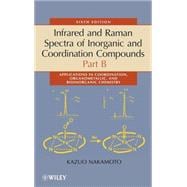
What is included with this book?
Kazuo Nakamoto, PhD, received his DSc from Osaka University in 1953 and stayed on as a faculty member until 1957. In 1958, he joined the faculty at Clark University, moved to Illinois Institute of Technology in 1961, and then to Marquette University in 1969, where he became the university's first Wehr Professor of Chemistry. Dr. Nakamoto has directed the research of more than eighty-five graduate students and postdoctoral associates, and has published over 225 research papers, twenty review articles, and twelve books.
ABBREVIATIONS.
1. Applications in Coordination Chemistry.
1.1. Ammine, Amido, and Related Complexes.
1.2. Complexes of Ethylenediamine and Related Ligands.
1.3. Complexes of Pyridine and Related Ligands.
1.4. Complexes of Bipyridine and Related Ligands.
1.5. Metalloporphyrins.
1.6. Metallochlorins, Chlorophylls, and Metallophthalocyanines.
1.7. Nitro and Nitrito Complexes.
1.8. Lattice Water and Aquo and Hydroxo Complexes.
1.9. Complexes of Alkoxides, Alcohols, Ethers, Ketones, Aldehydes, Esters, and Carboxylic Acids.
1.10. Complexes of Amino Acids, EDTA, and Related Ligands.
1.11. Infrared Spectra of Aqueous Solutions.
1.12. Complexes of Oxalato and Related Ligands.
1.13. Complexes of Sulfate, Carbonate, and Related Ligands.
1.14. Complexes of b-Diketones.
1.15. Complexes of Urea, Sulfoxides, and Related Ligands.
1.16. Cyano and Nitrile Complexes.
1.17. Thiocyanato and Other Pseudohalogeno Complexes.
1.18. Complexes of Carbon Monoxide.
1.19. Complexes of Carbon Dioxide.
1.20. Nitrosyl Complexes.
1.21. Complexes of Dioxygen.
1.22. Metal Complexes Containing Oxo Groups.
1.23. Complexes of Dinitrogen and Related Ligands.
1.24. Complexes of Dihydrogen and Related Ligands.
1.25. Halogeno Complexes.
1.26. Complexes Containing Metal–Metal Bonds.
1.27. Complexes of Phosphorus and Arsenic Ligands .
1.28. Complexes of Sulfur and Selenium Ligands.
References.
2. Applications in Organometallic Chemistry.
2.1. Methylene, Methyl, and Ethyl Compounds.
2.2. Vinyl, Allyl, Acetylenic, and Phenyl Compounds.
2.3. Halogeno, Pseudohalogeno, and Acido Compounds.
2.4. Compounds Containing Other Functional Groups.
2.5. p-Bonded Complexes of Olefins, Acetylenes, and Related Ligands.
2.6. Cyclopentadienyl Compounds.
2.7. Cyclopentadienyl Compounds Containing Other Groups.
2.8. Complexes of Other Cyclic Unsaturated Ligands.
2.9. Miscellaneous Compounds.
References.
3. Applications in Bioinorganic Chemistry.
3.1. Myoglobin and Hemoglobin.
3.2. Ligand Binding to Myoglobin and Hemoglobin.
3.3. Cytochromes and Other Heme Proteins.
3.4. Bacteriochlorophylls.
3.5. Hemerythrins.
3.6. Hemocyanins.
3.7. Blue Copper Proteins.
3.8. Iron–Sulfur Proteins.
3.9. Interactions of Metal Complexes with Nucleic Acids.
References.
Index.
The New copy of this book will include any supplemental materials advertised. Please check the title of the book to determine if it should include any access cards, study guides, lab manuals, CDs, etc.
The Used, Rental and eBook copies of this book are not guaranteed to include any supplemental materials. Typically, only the book itself is included. This is true even if the title states it includes any access cards, study guides, lab manuals, CDs, etc.